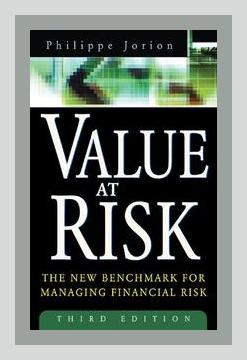Finance and AccountingRisk Management
Introduction
Philippe Jorion’s “Value at Risk: The New Benchmark for Managing Financial Risk” is a seminal work that delineates the concept and application of Value at Risk (VaR) as a powerful tool for risk management in finance. The 2006 edition encapsulates updated methodologies, real-world examples, and advancements in financial risk assessment. This summary highlights key points and actionable advice derived from the book to aid financial professionals in managing risk effectively.
1. Understanding Value at Risk (VaR)
Key Points
- VaR is a statistical technique used to measure the risk of loss in a portfolio.
- It quantifies the maximum expected loss over a given time period at a certain confidence level.
- VaR consolidates risk into a single number, making it a versatile tool for various financial entities.
Actions
- Implement VaR in your risk management toolkit to provide a clear picture of potential losses.
- Use a 99% confidence level to adhere to industry standards, ensuring credibility and consistency in risk assessment.
Example
Jorion provides an example of a portfolio with a 1-day 99% VaR of $1 million. This signifies that there is a 1% chance the portfolio will lose more than $1 million in a day.
2. Models and Methods of VaR Calculation
Key Points
- The classification of VaR methods: Parametric (Variance-Covariance), Historical Simulation, and Monte Carlo Simulation.
- Parametric VaR assumes normal distribution and uses statistical parameters (mean and standard deviation).
- Historical Simulation uses actual historical data to simulate past returns.
- Monte Carlo Simulation generates a large number of random price paths based on the portfolio’s risk factors.
Actions
- Choose the right VaR model based on the nature of your portfolio and the data availability.
- Integrate back-testing to validate the chosen VaR model, refining as necessary for accuracy.
Example
In historical simulation, Jorion discusses analyzing past returns over a 250-day period to estimate VaR, thus allowing risk predictions based on previous market behaviors.
3. Implementing VaR in Financial Institutions
Key Points
- Financial institutions can use VaR for internal risk control, regulatory compliance, and capital allocation.
- VaR can be integrated into the risk management frameworks of banks and investment firms.
Actions
- Align your institution’s risk management practices with regulatory standards such as Basel II, which incorporates VaR in determining capital reserves.
- Regularly communicate VaR results to senior management and stakeholders to maintain transparency and informed decision-making.
Example
J.P. Morgan’s adoption of the RiskMetrics system is highlighted, where daily VaR reports aid in maintaining market risk within acceptable limits.
4. VaR and Risk Management Techniques
Key Points
- VaR can complement other risk management techniques like stress testing and scenario analysis.
- Scenario analysis evaluates the impact of hypothetical adverse events on the portfolio.
- Stress testing examines extreme but plausible adverse market conditions.
Actions
- Employ scenario analysis to gauge the effect of potential market disruptions, such as financial crises or geopolitical events.
- Perform regular stress tests to ensure the resilience of your portfolio under extreme conditions.
Example
Jorion illustrates the application of scenario analysis by simulating a sudden interest rate hike and its impact on a bond portfolio.
5. Challenges and Limitations of VaR
Key Points
- VaR assumes market conditions remain static, which may not always be realistic.
- It may not adequately capture extreme tails of loss distributions (events of very low probability but high impact).
- Model risk and data limitations can affect accuracy.
Actions
- Always complement VaR with other risk assessment tools like Expected Shortfall (ES) and Conditional VaR.
- Continuously review and update data inputs to ensure precision in VaR calculations.
Example
The book discusses the downfall of Long-Term Capital Management (LTCM) as a cautionary tale where reliance on VaR without accounting for liquidity risk contributed to its failure.
6. VaR for Non-Financial Corporations
Key Points
- Non-financial corporations can use VaR to manage market risks like commodity prices, foreign exchange rates, and interest rates.
- It helps in making informed financial decisions that align with the company’s risk tolerance.
Actions
- Apply VaR to assess and mitigate risks associated with fluctuations in commodity prices, critical for manufacturing firms.
- Use foreign exchange VaR to manage currency risks in multinational operations.
Example
Jorion provides insight into a multinational corporation using VaR to hedge against currency risk, optimizing its exposure to exchange rate fluctuations.
7. Regulatory and Compliance Aspects
Key Points
- Financial regulation incorporates VaR to determine capital requirements and ensure stability in the banking sector.
- Basel Accords stipulate the use of VaR for calculating market risk capital.
Actions
- Ensure compliance with regulatory mandates by adopting standardized VaR models.
- Regularly review risk management policies to adhere to evolving regulatory frameworks.
Example
Basel II’s regulations are discussed, requiring banks to maintain capital reserves proportional to their VaR estimates, fostering financial system stability.
8. Technological Integration in VaR
Key Points
- Technological advancements have streamlined the computation and application of VaR.
- High-frequency trading and real-time risk assessment benefit from improved computational power and algorithms.
Actions
- Leverage sophisticated software and platforms for real-time VaR reporting and risk analysis.
- Train staff in utilizing advanced analytical tools to enhance risk management capabilities.
Example
Jorion references RiskMetrics’ software, providing standardized solutions for VaR calculations, enhancing accuracy and efficiency.
Conclusion
“Value at Risk: The New Benchmark for Managing Financial Risk” by Philippe Jorion offers an exhaustive exploration of VaR as an indispensable risk management tool. Through examples and actionable steps, the book illustrates how financial professionals can implement, validate, and optimize VaR for comprehensive risk assessment. Embracing VaR, alongside complementary tools and regulatory compliance, equips institutions to navigate the complexities of financial risk effectively.
Note: The summary provided is derived and structured based on themes and examples presented in Philippe Jorion’s book, ensuring a thorough representation of its primary elements for practical implementation in risk management.
